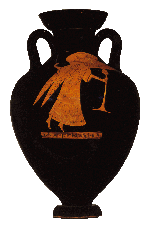The Ancient Greek World Index
 Pottery provides the best archaeological
evidence for the movements of the Greeks
and the spread of their trade around the Mediterranean and Black Sea
basins. Central and northern Italian Etruscan cemeteries have
thousands of Greek vases in their tombs.
Pottery provides the best archaeological
evidence for the movements of the Greeks
and the spread of their trade around the Mediterranean and Black Sea
basins. Central and northern Italian Etruscan cemeteries have
thousands of Greek vases in their tombs.
It is widely assumed that Etruria traded lump iron, lead and bronze in exchange for Greek pottery.
Corinth dominated the pottery export trade up to the mid 6th century BC. By around 525 BC Athens had established a monopoly in luxury wares and in time effectively drove Corinthian and all other regional styles from the marketplace.
The key to Athens's success lay in the quality and variety of the shapes and the wide range of pictorial scenes.
Coarse-ware pottery was produced locally
throughout the Greek world wherever clay was available.